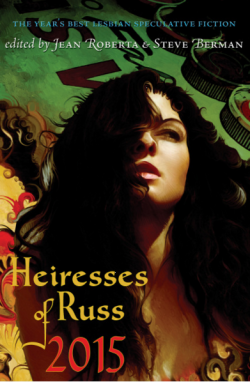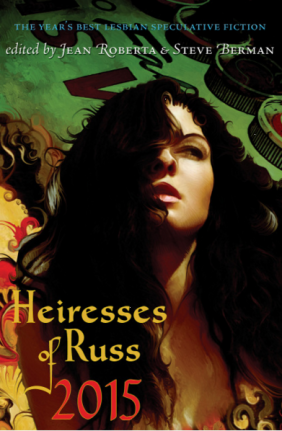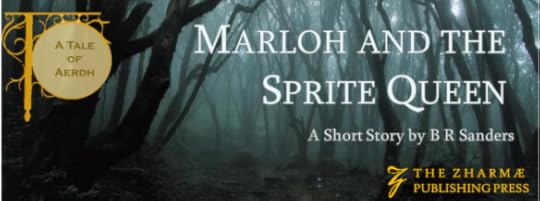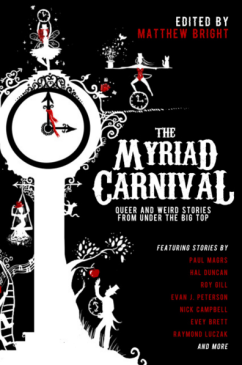B.R. Sanders's Blog, page 16
October 28, 2015
Debrief: “Real Monsters”

Scylla and Charybdis are sea monsters, but they didn’t start that way. In “Real Monsters,” Scylla tells her story. In Scylla’s version of events, what lies between Scylla and Charybdis is not death and destruction but a radical and vibrant love story.
Publication date: First published in Cactus Heart, issue 8, on 6/4/2014.
Reprinted in Heiresses of Russ 2015 on 10/23/2015.
Completion date: 11/3/2013
Number of times subbed:
Six–four rejections and two acceptances. One of the acceptances was an initial acceptance to publish, and the second was an acceptance to publish as a reprint.
The story of the story:
I wrote this one to a call for stories featuring queer women and the theme “over and under the sea.”
I had that call banging around in my head when I went on a trip with my ex to meet her family. That trip didn’t go well; her family could not get my preferred pronouns right, nor did they seem to have any interest in doing so. Not a queer friendly situation, much less trans-friendly.
The idea came to me very suddenly, born out of I’m not sure what, but the upshot is that I ended up in a crappy little Starbucks looking up elements of myth about Scylla and Charybdis while I sketched out the plot. I wrote the thing in a single sitting, there in that Starbucks, the day we left her family behind and started another leg of the trip. Writing it was an act of catharsis, an exorcism of vicious defiance I’d been carrying for days.
Placing the story:
This one wasn’t easy to place. It’s a retelling of Greek myth, still with the same setting but told in modern colloquial language and subrversively recast. It’s kind of spec fic but kind of not–there are sea creatures and gods and goddesses, but it’s a Greek myth retelling and those are often perceived to be tongue-in-cheek literary as often as not as well. It was another one that was, frankly, just kind of…weird.
I sent it to the lit mag that issued the call, and was rejected. I sent it to a couple of spec fic lit mags, and was rejected. I tried a literary lit mag that had a call going for a fanfic-y type thing, and this piece seemed to fit, but was rejected. I saw Cactus Heart listed on Lambda Literary, and their mission statement said they were after “spiny writing & art—sharp, relentless, coursing with energy and able to thrive in the harshest of places, all while maintaining a vulnerable, succulent interior.” Hell, I thought, this one is spiny and vulnerable. So I subbed “Real Monsters” to them, and they took it! An ethos fit, I’d call it.
A few months later I saw the call from Lethe Press for submissions to their annual Heiresses of Russ collection–reprints of lesbian fiction from the past year. I sent them “Real Monsters” and “Beneath the Dane Hills” for consideration–both fit the bill–and they chose “Real Monsters”.
Want posts like this delivered to your inbox? Sign up for my newsletter!


October 27, 2015
Disrupting Publishing Linkspam: 10/27/2015
It’s that time again: that time every week where I round up links to articles written by marginalized people pushing back against oppression in publishing. I’m aggregated as many marginalized voices as possible from as many vectors as possible, and the more intersectional the better. As always if you’ve read something I missed please link it in the comments.
“The ‘Anyone Can Write’ Argument in Laura Amy Schlitz’s THE HIRED GIRL” by Debbie Reese
Is Schlitz–through her characters–pushing against the growing call for diversity of authors? I think so, and, I think it is an overt move on the part of Schlitz, her editor, and her publishing house.
“Accuracy or Bias: On Prejudicial Characters in Children’s Literature and Beyond” by Justina Ireland for Book Riot
It doesn’t matter that this book may be offensive to Jewish or Native people. As long as it satisfies the majority, in this case a white, Christian audience, it must be “quality.” The book is one more microaggression against readers that fall outside of the imagined audience, and the conversation surrounding the book further marginalizes these groups because it makes very clear that their opinion is inconsequential. A book that is offensive to them can still be considered award worthy.
The PW Publishing Industry Salary Survey 2015: A Younger Workforce, Still Predominantly White

“Same Old Script” by Alisha Harris at Slate
A Writers’ Guild of America report released earlier this year noted that staff employment for people of color actually decreased between the 2011–12 season and 2013–14 season, from a peak of 15.6 percent to 13.7 percent. The number of executive producers of color also decreased in those seasons, from 7.8 percent to 5.5 percent. While the 2014–15 season may have seen those numbers increase thanks to the addition of a few shows with diverse casts, such sharp declines demonstrate how tenuous progress in Hollywood can be.
The Rhimes effect onscreen is real. But can the remarkable diversity in those few writers’ rooms spread to shows across the television landscape?
Girl Monsters: Sofia Samatar interviews Sarah McCarry
I want to ask you about the cover of About a Girl—because isn’t this the first mass-market YA cover to show two girls kissing??
It’s the first cover of a YA novel published by a Big 5 publisher (Big 4 now? I can’t keep track) to feature two girls kissing, yes! It came about because I am a belligerent pest, is the short version of the story. I am still delighted about that.
“Sleeps With Monsters: Strong Female Characters and the Double Standard” by Liz Bourke for Tor.com
But the double standard of content, the double standard of criticism applied, bothers me really quite fundamentally. We fall into the error of really rather relentlessly applying criticism to female characters. They’re too domestic! They aren’t domestic enough! They have too little agency! Or too much, having unbelievably few constraints on their choices! They’re too violent, too shallow, too brittle. They’re too gentle, too generous, too forgiving, too soft. They’re insufficiently maternal, or too much so. They’re too independent! They’re not independent enough!


October 25, 2015
Roundup: October 19-25, 2015
[image]
Wanderings on the Internet
lorem ipsum
lorem ipsum
If you are so inclined, browse the Supernatural Haikus.
Writing Update
lorem ipsum.
Want posts like this delivered to your inbox? Sign up for my newsletter!


October 23, 2015
Announcement: #WriteInclusively Guest Spot over at SC Write!
Hi friends!
If you’re interested in writing about writing you may want to check out the guest post I wrote over at SC Write for the #WriteInclusively campaign called “My Stories Will Be Intersectional Or They Won’t Be Worth Writing.”
Many thanks to SC for giving me space on his blog!
-B


Announcement: “Real Monsters” in HEIRESSES OF RUSS 2015!

OH GUESS WHAT MOAR ANNOUNCEMENTS!
I am honored that my story, “Real Monsters”, is included in Heiresses of Russ 2015: The Year’s Best Lesbian Speculative Fiction.
The fact that my story is sandwiched between Nicola Griffith’s “Cold Wind” and Alex Dally MacFarlane’s “Because I Prayed This Word” gives you a sense of just how excellent this collection is.1 Again, I’m truly honored, and if queer spec fic is your thing I encourage you to check out the anthology!
About “Real Monsters”
Scylla and Charybdis are sea monsters, but they didn’t start that way. In “Real Monsters,” Scylla tells her story. In Scylla’s version of events, what lies between Scylla and Charybdis is not death and destruction but a radical and vibrant love story.
About the Anthology
Stories about lesbians, women who choose women as primary partners, lovers, playmates, and co-conspirators, tend to go where few men have gone before. Most of the real-life issues that lesbians must deal with, as women and as members of non-mainstream communities, appear in these stories in metaphorical form or as plausible scenarios in a future or alternate world. Lesbianism itself was routinely described by the conservatives of the past as “impossible.” The formula of “woman + woman” is thus logically connected with other phenomenon formerly considered impossible: magic, witchcraft, folk cures, scientific discoveries, alternate methods of producing offspring, space travel, communication with beings who are not human or not living in human bodies, historical accounts that have been suppressed or denied. The Heiresses of Russ series seeks to offer readers the best lesbian-themed speculative fictions stories published the prior year.
1Ok, full disclosure: when I saw the table of contents I was a bit flabbergasted that my story had been selected. Probably I wouldn’t even have sent in a story for consideration if I’d known all of these incredibly talented authors I admire so much were in the running. (I have major writer Imposter Syndrome).


October 22, 2015
Announcement: “The Sharpshooter” in THE MYRIAD CARNIVAL–Forthcoming from Lethe Press!
I’m super excited to tell you that one of my short stories, “The Sharpshooter”, will be included in The Myriad Carnival–a forthcoming anthology from Lethe Press in February 2016 but is available for preorder now.
About the Anthology
Roll up, roll up… The circus has long been that dream palace, intoxicating with so many lights and sights, sounds and smells. Sawdust, popcorn, strange animals, make-up, and the sweat of the roustabouts. The circus intrudes into the life of the ordinary and mundane and brings magic. Editor Matthew Bright invites you to the enjoy the sixteen attractions of the fantastical and dark Myriad Carnival.
About “The Sharpshooter”
Never look too close at anything in the Myriad Carnvial; everything there is an illusion. Beneath the makeup and the wig and the costume in the gunslinger’s tent is Yves: French, genderqueer, armed with an enchanted gun. Trouble comes for Yves, but what happens when the West’s best shot is no great shot at all?


October 21, 2015
How to Build And Break A World
This post is more or less what I presented as a workshop at Sirens a couple of weeks ago. If you find this useful I have worksheets! Here is an example where I’ve gone through this process with my book Resistance. Here is a blank sheet for you to work from.
I love worldbuilding. It’s what drew me to writing in the first place. The theme of the 2015 Sirens conference was women rebels and revolutionaries in fantasy and science fiction. When I saw the theme and the call for submissions, I immediately thought of Resistance–my debut novel which features women fighting back, women assassins, women leading a coup, women taking over a city. I thought “hey, I’ve written something like this! I can make a presentation on this!” So I pitched something. And they accepted–on the condition that I turn it into a workshop.
That was…daunting. Talking at people I can do. They teach you how to do that in grad school. But a workshop? A writing workshop? Me? Well…shit. I could try. I said yes, I’d reformat it into a mini-workshop for writers.
The gist of the workshop is worldbuilding with worldbreaking in mind. That is, how do you build a world when you know you want to disrupt it, and how to you make the world, the disruption, and the aftermath all ring true? The way you do it, I think, is piecemeal.
First You Have Build It
The key to worldbuilding well is to create cultures and world that follow the rules of actual real-life cultures in new and unexpected ways. That is, cultures are systems that perpetuate themselves by way of rituals, laws, religion, kinship, economic practices, etc. They mutate, they shift, but the important thing to capture is that they persist. Make something sustainable, something that will keep going until you disrupt it.
Resources
Societies organize around resources; what is scarce often (but not always) becomes what is valuable. To what extent is this true in the world you want to create? Are there class distinctions, and if so, how might one tell the rich from the poor? If there is a magic system, is magic accessible to everyone, or only certain people? If only certain people can perform magic, then how are they able to access it–through education? Through bloodlines? Through some combination of the two? And what does it mean if magic is scarce? Knowing who has what resources is essentially understanding your world’s status quo.
Power
What will the people with the resources do to keep those resources? In other words, what is done to maintain the status quo? How did it become the status quo?
Was it through curtailing of choice? Through false choices? Through limited access for some and wide access for others? Does it depend on the resource? How? It is something more over (like violence)? Or something more subtle (like education or structures of politeness)?
Remember intersectionality matters even in made up worlds and cultures. Likely there is more than one axis of power/marginality at play in what you’re creating. Think through how resource scarcity and expressions of power shape that axis and the identities it might embody. Think about how individuals embodying multiple constellations of identities are positioned in that society.
Think, too, about how many of these axes are transposed straight from our world, and how many are your own creation. Does homophobia make sense to exist here? Why or why not?
Then You Can Break It
As history as shown, there are a thousand ways to disrupt a culture. Cultures can be broken from within or from without. From within, they can change slowly but drastically, transformed by reformation. Or they can be rewritten in moments by revolutionaries. External pressures, like invasions or assassinations, can cause vacuums of power that previously marginalized people can suddenly exploit. Instead of a step-by-step process as in the previous section, this section is more of a toolbox. Choose what works for you: maybe it’s one thing, maybe it’s a combination.
check out all these tools
Look through these complications. Look through the world/culture you built. How are you going to shake things up? Pick one, maybe two, of these complications and work out the basics of it below. Sketch out the who and what of your complication. What leads up to this complication? Who is involved? Why and how will this complication lead to lasting disruption in your culture/world?Remember to Rebuild
When the dust clears, who survives your complication? Who is standing tall, and who is nursing wounds? Did the complication change what resources are available? Did the complication change who the resources are available to? Was it a wholesale shift in resources (from one group to another) or was it a flattening of resources (even distribution)?
What did the complication change in terms of structures? Did everything change? Is the world a flat, marginalization-free utopia now? Or did some of those axes of power slip through the complication and continue to exist? Did the complication introduce new power axes? Or invert previous ones?
Maybe you don’t need to answer all of these questions. Maybe just need to know enough of the fall out to make a satisfying ending. But maybe this is set up for the next chapter of your story or the beginning of a new book–and in that case, these things bear a lot of thinking about.
I hope you found this helpful! I LOVE talking about worldbuilding; feel free to ask me about it anytime in my newsletter question form and/or leave copious comments on this post. And, again, here is a blank worksheet from the Sirens workshop downloadable for free for your use.
Want posts like this delivered to your inbox? Sign up for my newsletter!


October 20, 2015
Disrupting Publishing Linkspam: 10/20/2015
It’s that time again: that time every week where I round up links to articles written by marginalized people pushing back against oppression in publishing. I’m aggregated as many marginalized voices as possible from as many vectors as possible, and the more intersectional the better. As always if you’ve read something I missed please link it in the comments.
“I Sought Solace On My Bookshelf” by Daniel Jose Older for Buzzfeed
On Nov. 19, the night before police killed unarmed Akai Gurley in a Brooklyn stairwell, Daniel Handler made his racist watermelon quip toward Jacqueline Woodson as he presented her with a National Book Award. It was interpersonal anti-blackness that led him to make such a statement. Institutional anti-blackness had his back.
“‘Agendas’ in Fiction” by Kayla Whaley
How stories with non-marginalized characters are thoughtful with powerful themes, but all others have a clear “agenda”?
— Kayla Whaley (@PunkinOnWheels) October 13, 2015
//platform.twitter.com/widgets.js
An Interview with Effie Brown about Project Greenlight
Why did you argue with Damon?
“I had no choice really. I’ve been black and a woman all my life. I have worked in this business for 20 years. I’m 43. It was one of those things. Literally in that moment, was I going to risk public humiliation, bringing up this opinion, or deal with shame and excuses: ‘You let that go by?’ That’s a big responsibility. I was more afraid of my mother: ‘That’s how we raised you and sacrificed, that’s it? When the time was for you to stand and be counted?’ That’s all that went thorough my head: damned if I was going to do that.
“Stories, Culture, and Conversation: An Interview with Roshani Chokshi and Yukimi Ogawa” by Catherine Krahe in Strange Horizons
I remember receiving a rejection that cut my heart to the quick because the editor said she just “didn’t know where the story would live.” And I couldn’t tell whether that referred to the writing and the editor’s belief that it didn’t fit the genre or whether the diverse content made the story a jarring choice compared to the pieces she acquired.


October 19, 2015
Roundup: October 12-18, 2015

click banner to read story for free over at Blog Z!
Wanderings on the Internet
My elf-girl-enters-a-creepy-forest-and-must-survive-using-only-her-wits short story, “Marloh and the Sprite Queen”, is free to read over at Blog Z!
Did you miss the #WeNeedDiverseBlogs Twitter chat on Sunday? This chat focused on incorporating diversity features in book blogs. If your interested, look through the tag for ideas!
All Season 3 haikus are up over at the Supernatural Haiku Project.
Writing Update
The Search continues! Every time I think I’m close to the end of this draft another plot thread elbows its way end. I am now simultaneously writing and keeping an ongoing set of handwritten notes about the inevitable rewrite of the book. I’ve hit 132k words with the additional 4k words I wrote this week.
ALSO THIS HAPPENED:
Ahhhh ahhhhh doppelganger novel idea forming in my brain
— Bee Dragons Sanders (@B_R_Sanders) October 13, 2015
//platform.twitter.com/widgets.js
Want posts like this delivered to your inbox? Sign up for my newsletter!


October 17, 2015
Announcement: “Marloh And The Sprite Queen” is free-to-read at Blog Z!
Hi friends! Looking for a creepy short story to read? Have a hankering for a story featuring a clever elf girl? “Marloh and the Sprite Queen”, now up at Blog Z, might be right up your alley! Head over and check it out–it’s free-to-read!
And, of course, please feel free to leave comments, pass it around social media, etc, should you get the urge to do so.
-B



![CropperCapture[141]](https://i.gr-assets.com/images/S/compressed.photo.goodreads.com/hostedimages/1445647500i/16685305._SX540_.png)

![CropperCapture[121]](https://i.gr-assets.com/images/S/compressed.photo.goodreads.com/hostedimages/1445523320i/16665938.png)
![CropperCapture[140]](https://i.gr-assets.com/images/S/compressed.photo.goodreads.com/hostedimages/1445523320i/16665939._SX540_.png)
![CropperCapture[114]](https://i.gr-assets.com/images/S/compressed.photo.goodreads.com/hostedimages/1445140101i/16606055._SX540_.png)


